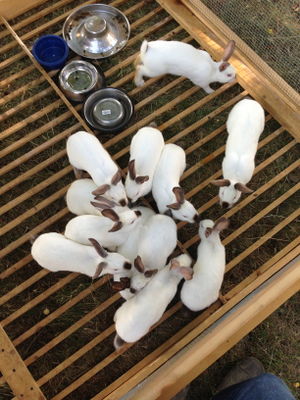Jacob Springs rabbit program (discontinued)
Jacob Springs Farm discontinued their meat rabbit program in 2014 due to the higher than average labor-to-return of the program, limited success in breeding rabbit that would thrive on grass and hay alone and an incident in which one of the farm children has his finger bitten off by a buck. (The finger was successfully re-attached). The program was given over to another farmer who continues to produce rabbits.
Contents
shelters
Movable grazing shelters were built in a number of different versions, each improving upon the last. One key feature was the slatted bottom allowing grazing but not escape. The ideal slat spacing was found to be 2" or less. Slats should be oriented in the same direction the shelter is intended to be moved. Unique runners and pulling handles were added to making moving the shelters easier.
Colony breeding and wintering
Successes - breeding, wintering, preventing burrow out while allowing den creation, low labor requirements, hay consumption
Challenges - rats eating babies.
Experiments in removing commercial feeds
Successes - hay
Failures - young rabbits on grass
Experiments in breeding in burrows
Being unsatisfied with the management intensity of breeding in cages or movable enclosures, we decided to try to allow rabbits to follow their instincts and kindle(give birth) in burrows. To accomplish this we made use of an area up against our house that was bounded on two sides by the foundation and on two sides by a concrete pathway - we reasoned that the concrete would prevent rabbits from burrowing out of the enclosure. Above ground, we used heavy woven wire fencing supported by stakes and blocked on the bottom by heavy railroad ties. The experiment was partly successful, but ultimately the system never reached a point of overall success before we terminated it. The rabbits quickly dug several burrows that were deeper than we could see or reach the bottom with our arms. They did kindle you in the burrows, some of which reached an age of beginning to explore outside the nest before they were killed by our farm cats. Two females died in their burrows shortly after kindling of unknown disease and another showed signs of parasite load. This may have been due to having limited access to new ground, perhaps heat stress played a part due to that location and nutrition may have been a problem since they were being fed primarily hay, grass clippings and vegetable scraps. Ultimately, it proved difficult to achieve success at breeding due to a combination of factors. We probably tried to change too much at once and never answered our questions conclusively.
